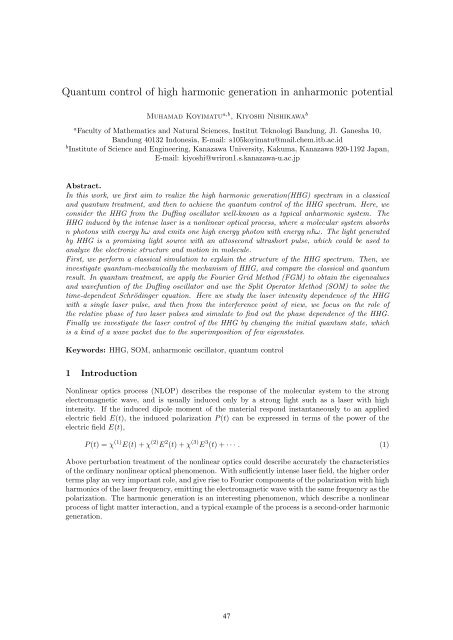RECENT DEVELOPMENT IN COMPUTATIONAL SCIENCE
RECENT DEVELOPMENT IN COMPUTATIONAL SCIENCE
RECENT DEVELOPMENT IN COMPUTATIONAL SCIENCE
You also want an ePaper? Increase the reach of your titles
YUMPU automatically turns print PDFs into web optimized ePapers that Google loves.
Quantum control of high harmonic generation in anharmonic potential<br />
Muhamad Koyimatu a,b , Kiyoshi Nishikawa b<br />
a Faculty of Mathematics and Natural Sciences, Institut Teknologi Bandung, Jl. Ganesha 10,<br />
Bandung 40132 Indonesia, E-mail: s105koyimatu@mail.chem.itb.ac.id<br />
b Institute of Science and Engineering, Kanazawa University, Kakuma, Kanazawa 920-1192 Japan,<br />
E-mail: kiyoshi@wriron1.s.kanazawa-u.ac.jp<br />
Abstract.<br />
In this work, we first aim to realize the high harmonic generation(HHG) spectrum in a classical<br />
and quantum treatment, and then to achieve the quantum control of the HHG spectrum. Here, we<br />
consider the HHG from the Duffing oscillator well-known as a typical anharmonic system. The<br />
HHG induced by the intense laser is a nonlinear optical process, where a molecular system absorbs<br />
n photons with energy �ω and emits one high energy photon with energy n�ω. The light generated<br />
by HHG is a promising light source with an attosecond ultrashort pulse, which could be used to<br />
analyze the electronic structure and motion in molecule.<br />
First, we perform a classical simulation to explain the structure of the HHG spectrum. Then, we<br />
investigate quantum-mechanically the mechanism of HHG, and compare the classical and quantum<br />
result. In quantum treatment, we apply the Fourier Grid Method (FGM) to obtain the eigenvalues<br />
and wavefuntion of the Duffing oscillator and use the Split Operator Method (SOM) to solve the<br />
time-dependent Schrödinger equation. Here we study the laser intensity dependence of the HHG<br />
with a single laser pulse, and then from the interference point of view, we focus on the role of<br />
the relative phase of two laser pulses and simulate to find out the phase dependence of the HHG.<br />
Finally we investigate the laser control of the HHG by changing the initial quantum state, which<br />
is a kind of a wave packet due to the superimposition of few eigenstates.<br />
Keywords: HHG, SOM, anharmonic oscillator, quantum control<br />
1 Introduction<br />
Nonlinear optics process (NLOP) describes the response of the molecular system to the strong<br />
electromagnetic wave, and is usually induced only by a strong light such as a laser with high<br />
intensity. If the induced dipole moment of the material respond instantaneously to an applied<br />
electric field E(t), the induced polarization P (t) can be expressed in terms of the power of the<br />
electric field E(t),<br />
P (t) = χ (1) E(t) + χ (2) E 2 (t) + χ (3) E 3 (t) + · · · . (1)<br />
Above perturbation treatment of the nonlinear optics could describe accurately the characteristics<br />
of the ordinary nonlinear optical phenomenon. With sufficiently intense laser field, the higher order<br />
terms play an very important role, and give rise to Fourier components of the polarization with high<br />
harmonics of the laser frequency, emitting the electromagnetic wave with the same frequency as the<br />
polarization. The harmonic generation is an interesting phenomenon, which describe a nonlinear<br />
process of light matter interaction, and a typical example of the process is a second-order harmonic<br />
generation.<br />
47


